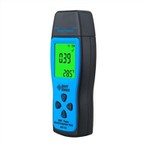1. Illumination test principle
Illuminance is the areal density of the luminous flux received on the illuminated plane. The illuminometer is an instrument used to measure the illuminance on the illuminated surface, and it is one of the most used instruments in illuminance measurement.
2. Structural principle of light meter
The illuminometer is composed of a photometric head (also known as a light-receiving probe, including a receiver, a V(λ) pair filter, and a cosine corrector) and a reading display. Its structure is shown in Figure 1.
Measurement steps and methods
In a work room, the illuminance should be measured at each work location (eg desk, workbench) and then averaged. For an empty room or a non-working room with no determined work location, if general lighting is used alone, a 0.8m-high horizontal plane is usually used to measure the illuminance. Divide the measurement area into squares (or close to squares) of equal size, measure the illuminance Ei at the center of each square, and its average illuminance is equal to the average of the illuminances of each point.
and energy. If the allowable measurement error of Eav is ±10%, the workload can be reduced by selecting the minimum measurement points according to the chamber shape index. The relationship between the two is listed in Table 1. If the number of lamps is exactly equal to the number of measuring points given in the table, the measuring points must be added.
Illuminance meter (or lux meter) is a special instrument for measuring luminosity and brightness. That is to measure the light intensity (illuminance) is the degree to which the object is illuminated, that is, the ratio of the luminous flux obtained on the surface of the object to the illuminated area. The illuminometer is usually composed of a selenium photovoltaic cell or a silicon photovoltaic cell and a microammeter, as shown in the figure.
Illuminance meter measurement principle:
Photovoltaic cells are photoelectric elements that directly convert light energy into electrical energy. When the light hits the surface of the selenium photocell, the incident light passes through the metal thin film 4 and reaches the interface between the semiconductor selenium layer 2 and the metal thin film 4, and a photoelectric effect is generated on the interface. The magnitude of the potential difference is proportional to the illuminance on the light-receiving surface of the photovoltaic cell. At this time, if an external circuit is connected, a current will flow through, and the current value will be indicated on a microammeter with lux (Lx) as the scale. The magnitude of the photocurrent depends on the intensity of the incident light and the resistance in the loop. The illuminance meter has a shifting device, so it can measure high illuminance and low illuminance.
Types of light meters:
1. Visual illuminometer: inconvenient to use, not very accurate, rarely used
2. Photoelectric illuminance meter: commonly used selenium photovoltaic illuminance meter and silicon photovoltaic illuminance meter
The composition and use requirements of the photocell illuminance meter:
1. Composition: Microammeter, shift knob, zero point adjustment, binding post, photocell, V(λ) correction filter, etc.
2. Requirements for use:
① Photocells use selenium (Se) photocells or silicon (Si) photocells with good linearity; they can maintain good stability after long-term operation, and have high sensitivity; when high E, choose high internal resistance photocells, which have low sensitivity and good linearity , not easily damaged by strong light exposure
②There is a V (λ) correction filter inside, which is suitable for the illumination of different color temperature light sources, and the error is small
③ A cosine angle compensator (opal white glass or white plastic) is added in front of the photocell because when the incident angle is large, the photocell deviates from the cosine law
④The illuminometer should work at room temperature or close to room temperature (photocell drift changes with temperature)
Calibration principle:
Let Ls irradiate the photocell vertically → E=I/r2, change r to obtain the photocurrent value under different illumination, and convert the current scale to the illumination scale by the corresponding relationship between E and i.
Calibration method:
Using the light intensity standard lamp, at a working distance similar to a point light source, change the distance l between the photocell and the standard lamp, record the readings of the galvanometer at each distance, and calculate the illuminance E according to the inverse square law of distance E=I/r2. A series of photocurrent values i with different illuminance can be obtained, which can be used as the change curve of photocurrent i and illuminance E, which is the calibration curve of the illuminometer.
Factors that affect the calibration curve:
The photocell and galvanometer need to be re-calibrated when they are replaced; the illuminometer should be re-calibrated after a period of use (generally 1-2 times within a year); high-precision illuminometers can be calibrated with light intensity standard lamps; The calibration range of the illuminance meter can change the distance r, and different standard lamps can also be used, and a small range current meter can be selected.






